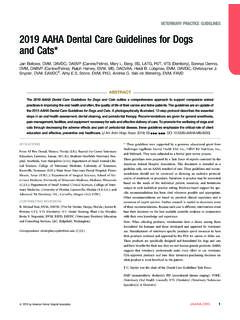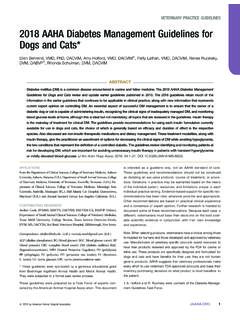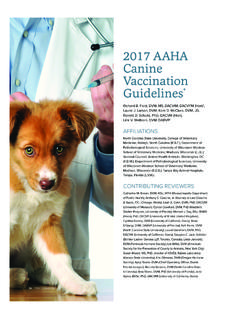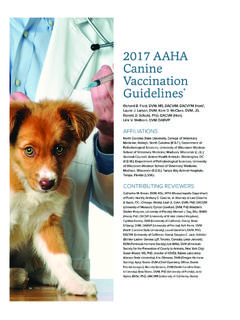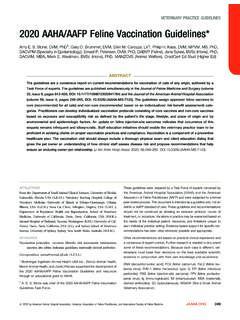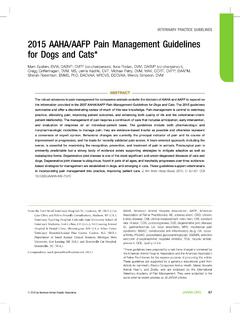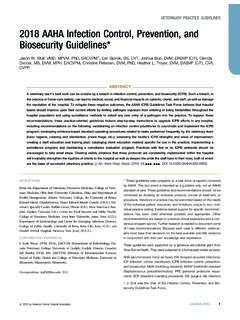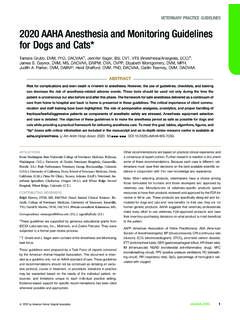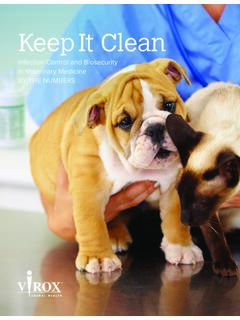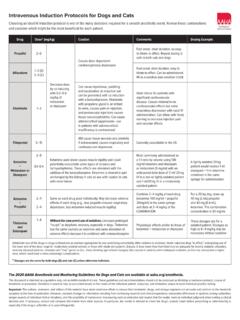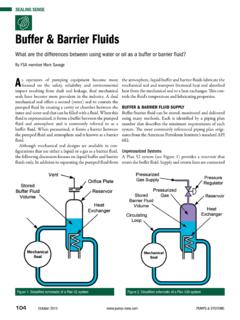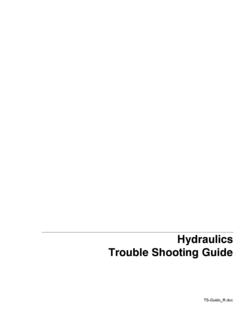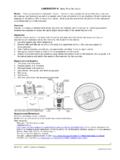Transcription of 2013 AAHA/AAFP Fluid Therapy Guidelines for Dogs and Cats
1 IMPLEMENTATIONTOOLKIT2013 AAHA/AAFP Fluid Therapy Guidelines for Dogs and CatsAAHA Standards of AccreditationThe aaha Standards include standards that address Fluid information on how accreditation can help your practice provide the best care possible to your patients, visit or call This ToolkitWhy Guidelines Matter ..3 Understand the Guidelines Key Points ..42013 AAHA/AAFP Fluid Therapy Guidelines for Dogs and Cats ..5 Improve Your Practice with a Model Protocol ..16 Make Uniform Decisions with a Model Algorithm ..17 Clarify Staff Roles and Responsibilities ..19 Answer 5 Common Client Questions ..20 Educate Clients with a Simple Handout ..21 Verify Key Tasks as You Perform Them ..22 Free web conference available now!
2 Join Heidi Shafford, DVM, PhD, DACVAA, for an engaging discussion on best practices for veterinary staff to implement the 2013 AAHA/AAFP Fluid Therapy Guidelines for Dogs and Cats. Earn 1 hour of CE credit. Go to 2013 aaha , Sarjeant3 Why Guidelines MatterVeterinary practice Guidelines , such as the recently published 2013 AAHA/AAFP Fluid Therapy Guidelines for Dogs and Cats, help to ensure that pets get the best possible care. Guidelines keep your hospital staff from medical director to veterinary assistant on the cutting edge of veterinary medicine. The 2013 AAHA/AAFP Fluid Therapy Guidelines for Dogs and Cats is the most complete and medically sound compilation of updates, insights, advice and recommendations ever developed for helping to ensure that your patients receive appropriate, individualized Fluid Therapy .
3 aaha Guidelines review the latest information that helps the veteri-nary team address treatment challenges and perform essential tasks in order to improve the health of the pet. In addition, Guidelines define the role of each staff member, so everyone on the health care team can work together to offer the best-quality medical care. Guidelines are just that a guide established by experts in a particular area of veterinary medicine. Guidelines do not outweigh the veterinarian s clinical judgment; instead, they help veterinarians develop and carry out treatment plans that meet each patient s needs and circumstances. Aligning your practice s protocols with guideline recommendations is a key step in ensuring that your practice continues to deliver the best care.
4 To support your dedicated efforts, aaha is pleased to offer this toolkit. Here, you ll find facts, figures, highlights, tips, client handouts and other tools you can use every day to implement the recommendations of the 2013 AAHA/AAFP Fluid Therapy Guidelines for Dogs and you for helping to advance our shared mission to deliver the best in companion animal medical care. Together, we can make a difference! Michael T. Cavanaugh, DVM, DABVPAAHA Chief Executive OfficerWhen selecting Fluid Therapy products, as well as other types of products, veterinarians have a choice of products formulated for humans and those developed and approved for veterinary use. Manufacturers of veterinary-specific products spend resources to have their products reviewed and approved by the Food and Drug Administration for canine and/or feline use.
5 These products are specifically designed and formulated for dogs and cats and have benefits for their use; they are not human generic products. aaha suggests that veterinary professionals make every effort to use veterinary FDA-approved products and base their inventory purchasing decisions on what product is most beneficial to the of Key PointsIndividualized care yFluid Therapy must be individualized and tailored to each patient. yTherapy is constantly re-evaluated and reformulated according to changes in patient status. yFluid selection is dictated by the patient s needs, including volume, rate and Fluid composition required, and location the Fluid is needed (interstitial versus intravascular). yThe appropriate route of Fluid administration depends on the patient s condition.
6 Use oral fluids for patients with a functioning gastrointestinal system and no significant Fluid imbalance. Use subcutaneous fluids to prevent losses. This route is not adequate for replacement Therapy in anything other than very mild dehydration. Use intravenous or intra-osseous fluids for patients undergoing anesthesia; for hospitalized patients not eating or drinking normally; and to treat dehydration, shock, hyperthermia or during anesthesia yThe decision about whether to provide fluids during anesthesia, and the type and volume used, depends on the patient s signalment, physical condition, and the length and type of procedure. yCurrent recommendations are for less than 10 mL/kg/hr to avoid adverse effects of hypervolemia.
7 Consider starting the anesthetic procedure at 3 mL/kg/hr in cats and 5 mL/kg/hr in Fluid ratesCat: Formula = 80 body weight (kg) per 24 hr Rule of thumb 2 3 mL/kg/hrDog: Formula = 132 body weight (kg) per 24 hr Rule of thumb 2 6 mL/kg/hrFluids for the sick patientAssess for three types of Fluid disturbances. 1. Changes in volume ( , dehydration, blood loss, heart disease)a. Fluid deficit calculation for dehydration: body weight (kg) x % dehydration = volume in liters to correct. See section on dehydration for more details on determining timeframe for replacement of Treatment for hypervolemia includes correcting underlying disease ( , chronic renal disease, heart disease) decreasing or stopping Fluid administration, and possibly use of Changes in content ( , hyperkalemia, diabetes or renal disease)a.
8 In general, the choice of Fluid is less important than the fact that it is isotonic. Volume benefits the patient much more than exact Fluid composition. Isotonic fluids will begin to bring the body s Fluid composition closer to normal, pending laboratory results that will guide more specific Fluid Changes in distribution ( , pleural effusion, edema)a. For pulmonary edema or pleural/abdominal effusions, stop Fluid and monitoring yProvide staff training on assessment of patient Fluid status, catheter placement and maintenance, use and maintenance of equipment related to Fluid administration, benefits and risks of Fluid Therapy , and drug/ Fluid incompatibility. yUse equipment and supplies that enhance patient safety, such as Fluid pumps, small Fluid bags, Luer-lock connections and Elizabethan AAHA/AAFP Fluid Therapy Guidelines for Dogs and Cats*AbstractIntroductionThese Guidelines will provide practical recommendations for Fluid choice, rate, and route of administration.
9 They are organized by general considerations, followed by specific Guidelines for perianes-thetic Fluid Therapy and for treatment of patients with alterations in body Fluid volume, changes in body Fluid content, and abnor-mal distribution of Fluid within the body. Please note that these Guidelines are neither standards of care nor American Animal Hospital Association ( aaha ) accreditation standards and should not be considered minimum Guidelines . Instead these Guidelines are recommendations from an aaha /American Association of Feline Practitioners (AAFP) panel of must be individualized and tailored to each patient and constantly re-evaluated and reformulated according to changes in status.
10 Fluid selection is dictated by the patient s needs, including volume, rate, and Fluid composition required, as well as location the Fluid is needed (interstitial versus intravascular). Factors to consider include the following: yAcute versus chronic conditions yPatient pathology ( , acid-base balance, oncotic pressure, electrolyte abnormalities) yComorbid conditionsA variety of conditions can be effectively managed using three types of fluids: a balanced isotonic electrolyte ( , a crystalloid such as lactated Ringer s solution [LRS]); a hypotonic solution ( , a crystalloid such as 5% dextrose in water [D5W]); and a synthetic colloid ( , a hydroxyethyl starch such as hetastarch or tetrastarch).General Principles and Patient AssessmentThe assessment of patient history, chief complaint, and physi-cal exam findings will determine the need for additional testing and Fluid Therapy .
